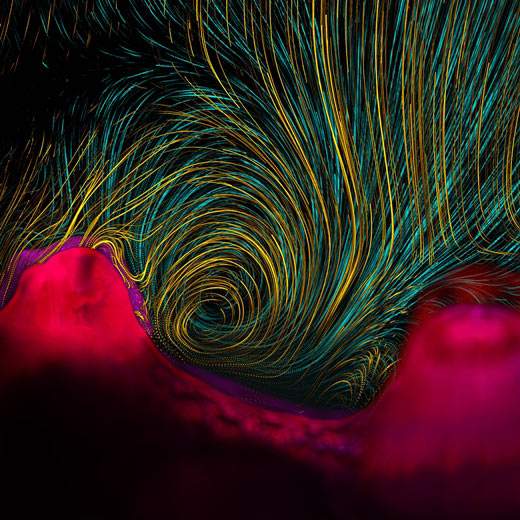Corals are far from the “living rocks” they are sometimes taken to be.
Invisible Coral Flows, which won first place in the photography category of the 2013
Science/National Science Foundation International Science & Engineering Visualization Challenge, captures the unseen flow generated by small hairs – cilia – covering the surface of a reef-building coral. The lines of flow reveal a previously unknown way in which the coral actively draws in nutrients and sweeps away waste products from the colony surface.
The image was featured on the cover of
Science, February 7, 2014.
It was created through an ongoing collaboration between
Dr. Assaf Vardi of the Weizmann Institute of Science’s Plant Sciences Department and Prof. Roman Stocker of the Massachusetts Institute of Technology (MIT). This research was funded by a grant from the Human Frontiers Science Program (HFSP).
To highlight the flow, Dr. Orr Shapiro of Vardi’s group – at the time a guest of Stocker’s group – and Dr. Vicente Fernandez of the Stocker lab used video microscopy to track particles in the water next to the coral surface. After recording two short videos 90 minutes apart and superimposing the successive frames from each video, they overlaid the resulting images to create the final composition. Artist considerations had a role as well: Drawing inspiration from Andy Warhol’s striking palette, the scientists used false color to help visualize the system. Pink represents the position of two coral polyps (Pocillopora damicornis) that were roughly 3 millimeters apart at the start of the video; purple represents their changed position at a later time; and gold and cyan highlight the flow patterns at the two time points, respectively. The spacing between points in the tracks represents different particle speeds, revealing where the flow is strongest in the vortex.
The image of the particle trajectories – not only rich in visual texture and form, but also in the amount of information they convey – made this photo a unanimous winner according to the judges.
“The image captures the beauty of coral-generated flows and epitomizes our discovery of their dramatic role in mass transport. Our finding has changed the way we think of corals – from passive entities dependent upon external flows, to active engineers of their own microenvironment,” says Shapiro. This new discovery has direct impacts on our understanding of corals’ physiology and their potential ability to cope with changes in their environment.
Dr. Assaf Vardi's research is supported by Charles Rothschild, Brazil; Roberto and Renata Ruhman, Brazil; Luis Stuhlberger, Brazil; the Lord Sieff of Brimpton Memorial Fund; the European Research Council; and the estate of Samuel and Alwyn J. Weber. Dr. Vardi is the incumbent of the Edith and Nathan Goldenberg Career Development Chair.
